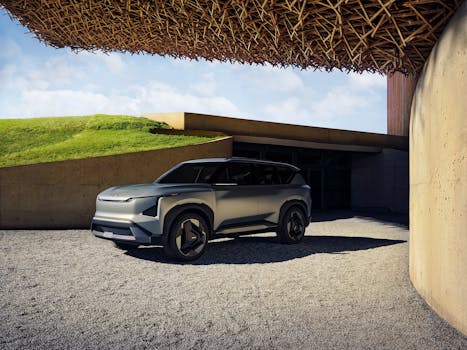Automotive marketing is a dynamic field that combines creativity, analytics, and consumer behavior understanding. It’s essential for the growth and sustainability of automotive brands. The success of any automotive business hinges on effective marketing strategies.
As technology advances, so do the methods and platforms used in automotive marketing. Today, dealerships, manufacturers, and marketers need to adapt to an ever-evolving landscape. By understanding these changes, businesses can create more targeted and impactful campaigns.
In this article, we dive into the various elements of automotive marketing. From digital strategies to the customer journey, each aspect plays a crucial role in reaching potential buyers. Let’s explore these components in detail.
The Importance of Branding in Automotive Marketing
Branding plays a pivotal role in the automotive industry. Strong branding can differentiate one vehicle from another in a crowded market. Therefore, establishing a unique identity is essential for automotive success.
Effective branding resonates with consumers and establishes trust. An emotional connection fosters brand loyalty, leading to repeat customers. Consistency in messaging enhances recognition, reinforcing the brand’s commitment to quality.
Automakers often adopt unique brand narratives that appeal to their target audience. This storytelling approach helps consumers relate to the brand on a personal level. Thus, it enhances the likelihood of purchase decisions.
Visual elements such as logos and color schemes are significant in automotive branding. They create an immediate connection with consumers. A well-designed visual identity can convey a brand’s values effectively.
Moreover, brands can leverage social media platforms to enhance visibility. Engaging content, such as videos and customer testimonials, can strengthen brand perception. Ultimately, effective branding is fundamental to a successful marketing strategy.
Understanding the Target Audience
Identifying and understanding the target audience is critical in automotive marketing. Knowing who your customers are helps tailor marketing strategies to meet their needs. This understanding leads to more effective communication.
Demographics, psychographics, and consumer behavior analytics play vital roles in identifying target audiences. Marketers can segment their audience based on age, income, lifestyle, and purchasing habits. This segmentation allows for more personalized marketing efforts.
Conducting market research helps identify potential trends and consumer preferences. This data-driven approach enables automotive businesses to stay ahead of competitors. Furthermore, adapting to changing consumer interests is necessary for long-term success.
Incorporating feedback from existing customers is also beneficial. Engaging with customers through surveys and social media can provide valuable insights. This information helps refine marketing strategies and develop new products that resonate.
Overall, a deep understanding of the target audience leads to improved engagement and sales. Automation tools can help streamline this process, making it easier to analyze consumer data and preferences.
Digital Marketing Strategies in the Automotive Sector
Digital marketing has transformed the automotive industry. Various channels, including social media, email marketing, and search engine optimization, are essential for reaching potential buyers. These strategies enhance visibility and engagement in a competitive landscape.
Search engine optimization (SEO) is imperative for driving organic traffic. By optimizing websites and content, automotive businesses can rank higher on search engine results pages. High visibility can significantly increase the chances of attracting new customers.
Social media platforms like Facebook, Instagram, and Twitter allow for direct interaction with consumers. Through engaging content and targeted advertising, brands can reach specific demographics. This two-way communication fosters relationships and builds community.
Email marketing also plays a crucial role in nurturing leads. Regular updates about new models, promotions, and events can keep potential customers informed. Personalizing these communications can further enhance responsiveness and engagement.
Lastly, analytics tools are vital for measuring digital marketing success. These tools help marketers track performance and optimize strategies. Regular assessment ensures that campaigns are effective and aligned with business goals.
The Customer Journey in Automotive Marketing
The customer journey is a critical consideration in automotive marketing. Understanding the stages buyers go through helps businesses tailor their strategies effectively. Each stage presents unique opportunities for engagement.
The journey typically begins with awareness, where potential customers first learn about a brand or vehicle. This phase can be driven by advertising, social media, or word of mouth. Capturing attention here is essential for further engagement.
The next step is consideration, where consumers evaluate options. Comprehensive online information, reviews, and comparisons facilitate this process. Providing valuable content can help guide consumers towards favorable decisions.
Once consumers decide, they move to the purchase stage. The buying experience should be seamless and user-friendly. Clear communication regarding financing options, warranties, and support enhances customer satisfaction during this phase.
After the purchase, maintaining customer relationships is vital. Post-sale engagement through follow-ups, service reminders, and loyalty programs encourages repeat business. A positive customer journey increases the likelihood of referrals and brand advocacy.
Leveraging Technology in Automotive Marketing
Technology plays an increasingly significant role in automotive marketing strategies. From data analytics to virtual reality, technology enhances how businesses approach their marketing efforts. Staying updated on technological advancements is essential for success.
Artificial Intelligence (AI) can automate customer interactions, providing personalized experiences. Chatbots on websites can answer questions instantly, facilitating engagement and improving customer service. These technologies can enhance operational efficiency while elevating the customer experience.
Virtual reality (VR) and augmented reality (AR) can transform the way consumers experience vehicles. Immersive technologies allow consumers to explore cars online before visiting dealerships. This innovative approach enhances the buying process and generates excitement.
Data analytics enables businesses to collect insights on consumer behavior and preferences. By analyzing data, marketers can refine their strategies and make informed decisions. This proactive approach leads to higher conversion rates and customer satisfaction.
Furthermore, mobile technology plays a crucial role in connecting with consumers. Mobile-friendly websites and apps cater to on-the-go consumers, providing convenience and accessibility. Optimizing for mobile is no longer optional; it’s essential in today’s market.
The Role of Customer Engagement
Customer engagement is crucial within automotive marketing. Building relationships with consumers fosters loyalty and repeat business. Engaged customers are more likely to recommend a brand to others, enhancing overall growth.
Interactive content is an effective way to boost engagement. Quizzes, polls, and online configurators allow consumers to explore their interests actively. This interactivity creates a memorable experience that keeps potential buyers interested.
Social media platforms are excellent for fostering community and engagement. Regular posts, contests, and user-generated content encourage participation. Engaged followers are more likely to convert into paying customers.
Creating loyalty programs can also enhance customer engagement. Incentives for repeat purchases and referrals encourage long-term relationships. Loyalty programs provide customers with added value, making them feel appreciated.
Ultimately, engaged customers contribute to positive word-of-mouth marketing. Strong relationships can lead to brand champions who actively promote their favorite brands. This organic marketing can be invaluable for automotive businesses.
Conclusion
Understanding automotive marketing is vital for navigating the ever-changing industry landscape. Effective branding, targeted audience insights, and digital strategies are key components. Additionally, focusing on customer journeys and leveraging technology further enhances success.
As technology evolves, so should marketing strategies. Embracing innovation and maintaining strong customer engagement will drive future success. By prioritizing these elements, automotive businesses can thrive in a competitive marketplace.
In conclusion, automotive marketing requires a multi-faceted approach. Focusing on these core elements will help businesses connect with consumers more effectively. Consequently, this connection can translate into increased sales and brand loyalty.


